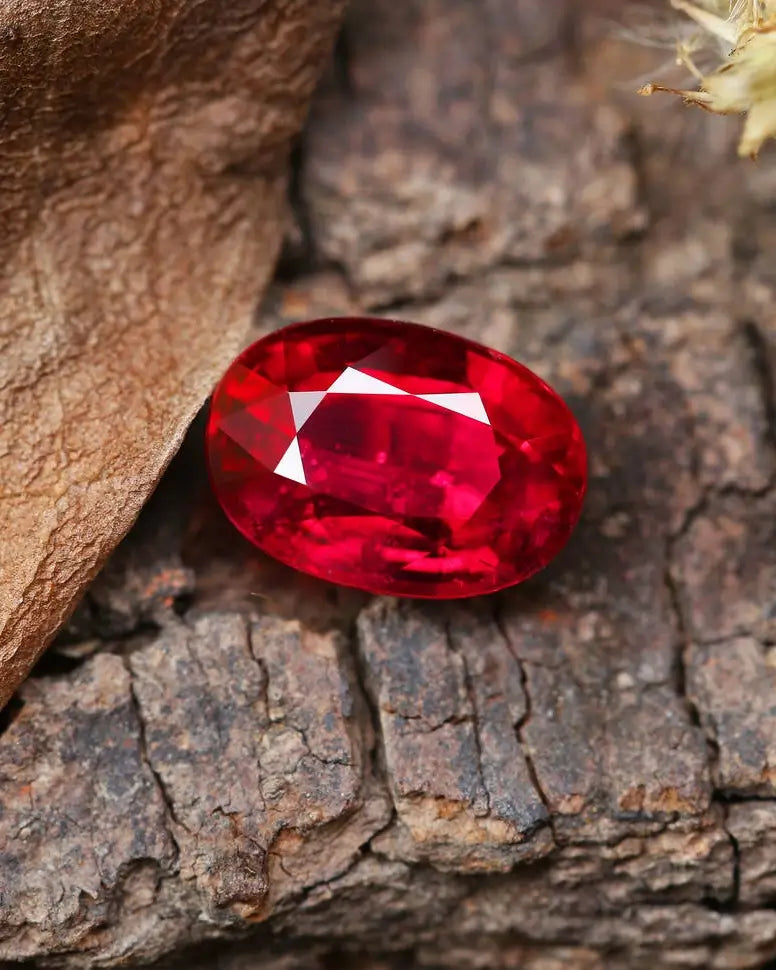-
Introduction to Garnet Birthstone
- Significance of Garnet for January births
- Range of colors and unique properties
- Beliefs about garnet’s benefits
-
Garnet Birthstone Meaning & History
- Origin of the name “garnet”
- Historical use in ancient civilizations
- Popularity in medieval and Victorian times
-
Types of Garnet
- Pyrope
- Almandine
- Spessartine
- Grossular
- Andradite
-
Famous Garnet Jewelry
- Smithsonian’s antique pyrope hair comb
- Bohemian garnet necklace
- Spanish King's garnet pendant
-
Health Benefits and Folklore
- Reputed health benefits according to Indian astrology
- Historical beliefs and myths
-
Sources of Garnet
- Historical and modern sources
- Notable regions and countries producing garnet
-
Garnet Birthstone Care & Cleaning
- Mohs scale hardness
- Tips for cleaning and storing garnet jewelry
-
Modern Uses of Garnet
- Industrial applications
- Technological advancements in garnet usage
-
Environmental Impact and Ethical Sourcing
- Environmental considerations in garnet mining
- Ethical sourcing and fair trade practices
-
The Future of Garnet Mining
- Sustainable mining methods
- Lab-grown garnets
Introduction to Garnet Birthstone

Those born in January are fortunate to have the beautiful and diverse garnet as their birthstone. Garnets are commonly red but also come in an extraordinary range of beautiful colors, including orange, yellow, purple, and vibrant green. There are even garnets that change color from blue to purple in different lighting. Some believe the true value of the garnet birthstone is its power to bring the wearer good health, wealth, and happiness.
Garnet Birthstone Meaning & History
The name “garnet” originates from the medieval Latin granatus, meaning “pomegranate,” in reference to the similarity of the red color. Garnets have been used since the Bronze Age as gemstones and abrasives. Necklaces studded with red garnets adorned the pharaohs of ancient Egypt. Signet rings in ancient Rome featured garnet intaglios that were used to stamp the wax that secured important documents. The clergy and nobility of the Middle Ages had a preference for red garnets.
Garnet is actually a group of several minerals. Five of these – pyrope, almandine, spessartine, grossular, and andradite – are important as gems. Pyrope and almandine range from purple to red. Spessartine is found in exciting oranges and yellows, while andradite is mostly yellow to green (the gem variety demantoid). Grossular may have the widest range, from colorless through yellow to reddish-orange and orangy red, as well as a strong vibrant green called tsavorite.
Types of Garnet

- Pyrope: Known for its deep red color, pyrope garnet was highly valued in ancient times. The name pyrope comes from the Greek pyrōpos, meaning “fiery-eyed,” and it is renowned for its intense and striking hue.
- Almandine: This type of garnet ranges from dark red to reddish-brown. It is one of the most common garnets used in jewelry. Almandine was popular among the nobility in the Middle Ages.
- Spessartine: This variety is famous for its vibrant orange and yellow colors. Spessartine garnets are often used in contemporary jewelry due to their bright and attractive appearance.
- Grossular: Grossular garnets exhibit a wide range of colors, from colorless to yellow, reddish-orange, and a striking green known as tsavorite. This variety is valued for its versatility and brilliance.
- Andradite: Andradite includes the demantoid garnet, which is prized for its brilliant green color. Demantoid garnets are among the most valuable and rarest garnets available.
Famous Garnet Jewelry
The Smithsonian’s antique pyrope hair comb is one of the most famous pieces of garnet jewelry. A large rose-cut garnet sits at the crest, much like a queen serenely surveying her court. The pyrope garnets that decorate this tiara-like jewel came from the historic mines in Bohemia (now part of the Czech Republic), and these rich red beauties were extremely popular during the Victorian era (1837–1901), when this piece was fashioned.

This antique pyrope garnet hair comb is part of the National Gem Collection at the Smithsonian Institution.
The Bohemian garnet necklace, made from clusters of small, deep red pyrope garnets, creates a vibrant and rich appearance highly coveted during the 19th century. These necklaces are often intricately designed with multiple strands and elaborate clasps, epitomizing the luxurious fashion of the Victorian era.
Another notable garnet artifact is the Spanish King's garnet pendant, a royal piece that features a massive, deeply colored garnet surrounded by diamonds. This pendant, believed to be a gift from an Eastern monarch, symbolizes the historical importance and cross-cultural appreciation of garnet gemstones.
Health Benefits and Folklore
Curious about your garnet birthstone’s reputed health benefits? According to Indian astrology, garnet helps eliminate negative feelings such as depression and guilt and instills greater self-confidence and mental clarity to promote creative thinking and peace of mind. In ancient and medieval times, gems like garnet were also thought to be remedies for inflammatory diseases and to soothe the angry heart.
Throughout history, garnets have been surrounded by myths and legends. In ancient Greek mythology, garnets were believed to be a symbol of love and were often exchanged between lovers to ensure a safe return and a speedy reunion. In Hindu tradition, garnets are considered to protect the wearer from nightmares and provide guidance in the dark.
Medieval warriors wore garnet amulets as they believed the stone would grant them protection and courage in battle. Additionally, some indigenous cultures view garnet as a sacred stone that can bring healing and protection to their communities.
Sources of Garnet

Garnets come from many different regions and countries. Bohemia was the primary source of the red pyrope garnets so popular during Victorian times. Today, the African continent supplies much of the world’s garnet. Namibia is now producing demantoids, and most of the bright green tsavorites in the market come from Kenya, Tanzania, and Madagascar. Namibia and Tanzania are also key sources of the rich orange-to-yellow spessartine garnets. For many years, Southern California’s Little Three mining area was known for producing this spellbinding gem. The birthstone for January is also found in Myanmar, Brazil, Iran, Afghanistan, Pakistan, India, and Sri Lanka, among other countries.
Small-scale artisanal miners, such as those near Voi in Kenya, are estimated to supply some 80% of the world's gems. These miners play a crucial role in the global garnet market, often working under challenging conditions to extract these precious stones.
Garnet Birthstone Care & Cleaning
The different types of garnet range between 6.5 and 7.5 on the Mohs scale of hardness. This means that this birthstone is more susceptible to damage than rubies, sapphires, and diamonds. So while not all garnets are good candidates for daily wear, they are ideal for earrings, brooches, and pendants. Give thought to how you store your garnet jewelry. If you let it rub against harder gems – again, think diamonds, rubies, and sapphires – it can be scratched. And in turn, garnet can scratch softer gems, such as opals or pearls.
Most garnets are not treated. Rarely, however, some garnets might be fracture-filled, whereby treaters try to improve the apparent clarity of the gem by filling surface-reaching breaks with a glass-like substance. Such treated stones require special care. Regardless, use of a soft brush with warm soapy water is always safe for cleaning garnets. Ultrasonic cleaners are usually safe, except for stones that have fractures or have been fracture-filled. Steam cleaning is not recommended.
Modern Uses of Garnet

Oval Garnet Engagement Ring - Eternal Flame | LEARN MORE
In contemporary times, garnets are not only prized for their beauty in jewelry but also for their industrial applications. Due to their hardness and abrasive properties, garnets are used in waterjet cutting, sandblasting, and as filtration granules. This dual role highlights the versatility and value of garnets beyond their aesthetic appeal.
Advancements in mining technology and increased awareness of environmental stewardship are shaping the future of garnet mining. Researchers are exploring more sustainable methods of extraction and processing to reduce the ecological footprint. Additionally, there is a growing interest in lab-grown garnets, which offer an environmentally friendly alternative without compromising on beauty or quality.

Oval Cut Garnet Wedding Rings - Radiant Ember | LEARN MORE
Environmental Impact and Ethical Sourcing
As with many gemstones, the mining of garnet can have environmental and social impacts. It's important to consider the source of garnets and opt for stones that are ethically mined. Some organizations and suppliers focus on sustainable mining practices, ensuring that the local environment and communities benefit from the extraction of these precious gems.
Consumers are encouraged to ask jewelers about the origin of their garnets and to seek out those who provide transparency in their sourcing. Supporting fair trade practices helps ensure that garnet mining contributes positively to the areas where these beautiful stones are found.
The Future of Garnet Mining
The future of garnet mining is geared towards sustainability and innovation. With the rising demand for gemstones, there is an increasing focus on developing eco-friendly mining techniques. Companies are investing in technologies that minimize environmental impact, such as using renewable energy sources and reducing water usage in the extraction process.

Lab-grown garnets are also gaining popularity as a sustainable option. These synthetic gems are created in controlled environments, ensuring consistent quality and reducing the need for mining. Lab-grown garnets possess the same physical and chemical properties as natural garnets, making them a viable alternative for consumers seeking environmentally responsible choices.
Conclusion
Garnets are not only a striking birthstone for January but also a gem with a rich history and wide-ranging applications. Whether you are drawn to their vibrant colors, historical significance, or industrial utility, garnets offer a unique blend of beauty and functionality. As the gemstone industry evolves, garnets continue to shine as a testament to nature's remarkable artistry.






